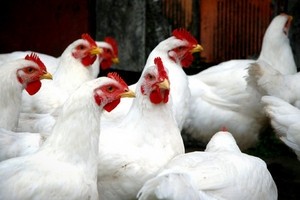US industrial sweet potato could be sustainable feed ingredient

Researchers with the University of Florida Institute of Food and Agricultural Sciences compared three cultivars of sweet potato to gauge their potential as a sustainable option for use in both animal feed and biofuel production. Results were published in the Journal of the Science of Food and Agriculture.
Interest in making a more sustainable biofuel, one that could be produced in different parts of the US, was the initial prompt for the research, said Ann Wilkie, professor of bioenergy and sustainable technology in the department of soil and water sciences at the University of Florida.
“Our goal in undertaking the study was looking at a bioethanol feedstock for the state of Florida, and like corn it [sweet potato] stores its carbon in the starch and we wanted to see if the vines could be used [as a feed ingredient] for relative feed value,” she told FeedNavigator.
The research team was also seeking a product that could be used in animal feed to reduce the friction between food and fuel production, she said. Finding a crop that could be used in both animal production and biofuel generation would improve land-use efficiency.
“It’s two feedstocks from the same plant,” she said.
In the study, different varieties of sweet potato vines were analyzed for their ability to be used in dairy cattle feed, said Wilkie. The roots were assessed for use in biofuel production.
The team found that the industrial sweet potato variety CX-1 offered the largest vine yield when compared with commercial plants Hernandez and Beauregard, and had better relative feed value (RFV), water-soluble carbohydrates (WSC), dry matter (DM) total digestible nutrients (TDN), metabolizable energy (ME) and organic matter (OM), the researchers said.
“The CX-1 industrial sweet potato is an ideal dual-purpose crop for tropical/subtropical climates that can be utilized as a non-grain-based feedstock for bioethanol production while contributing a valuable, high-yielding nutritional supplement for animal feed,” they said in the study.
Why sweet potato?
Attention needs to be given to the decrease in arable land to protect environmental sources food security in biofuel production, said the researchers. A novel approach would be to grow a crop that meets both needs.
The sweet potato appears to offer that option as it is highly productive and can be grown in low-quality land without minimal inputs of fertilizer and irrigation, they said.
Starch content found in industrial sweet potatoes improves their use in biofuel production, they said. And in previous studies other cultivars of sweet potato vines have been fed to dairy cattle as a replacement for brewer’s grain or cottonseed meal.
If vines from the industrial sweet potato CX-1 were superior to those from table varieties, then the plant could be offered as an option for feed and fuel production, the researchers said.
“If we’re going to grow a crop for biofuel and animal feed it would be nice to grow it for the animals we have here in Florida,” said Wilkie. “We don’t really have a hog industry – dairy and cow-calf [operations] are what we have.”
Producers already use co-products from biofuel production, but they have to be brought in from out of state, she said. “We need a closed loop system,” she added.
“We need biofuel alternatives and we’d like to have a feedstock that we could grow in Florida that would be local,” she said. “If you want to make renewable energy you want to have it made locally.”
The plant works well in sandy soil, which can be found throughout the Southeast, she said. And, the industrial variety examined does well in warm and subtropical climates.
The researchers initially wanted to compare the chemical components of sweet potato vines from the industrial variety to versions of the plant raised in the US for human consumption, but there was little information available on US plants, said Wilkie.
“We couldn’t find any other studies that could give that chemical analysis,” she said.
Comparisons
Samples of sweet potato vines and leaves were collected from two different growing seasons to compare yields, said the researchers. Vines were harvested 112 and 165 days after planting for the first year and after 172 days in the second year.
Yields were determined for both fresh vines and on a dry matter basis, they said. Roots were collected after the vines.
Plants were assessed for DM, OM, acid detergent fiber (ADF), neutral detergent fiber (NDF) and acid detergent lignin, they said. RFV was calculated and estimates were made for digestible energy (DE), ME and crude protein (CP).
Findings
Of the varieties tested, the CX-1 produced the largest fresh matter vine yield during both growth trials, said the researchers.
The CX-1 plant had less ADF and NDF; the highest RFV; largest amount of WSC, non-fiber carbohydrates, TDN; and greater values for energy and ME, they said. The Beauregard vines had the most CP, followed by the CX-1 and both had similar amounts of crude fat.
The industrial cultivar also had the largest amount of potassium, sodium, and iron, they said. Zinc concentrations were similar for the CX-1 and Hernandez; Beauregard vines had more calcium, magnesium and sulfur; and Hernandez vines had more phosphorus and copper.
The CX-1 vines had the largest concentration of in vitro organic matter digestibility after 165 days and saw the least degradation over time, said the researchers. But, the Beauregard variety lost the least CP.
“This study also shows that the vines from the table varieties could be used as an animal forage,” said Wilkie. “We grow a lot of sweet potatoes so maybe that will encourage feeding the vines to our animals as we feed ourselves.”
From the analysis completed the feed ingredient could be ensiled, but it also can be fed fresh or used in a total mixed ration, she said.
The study was a preliminary piece of research, said Wilkie. The next step will be to publish the rest of the data gathered and future efforts could include examining the use of sweet potato by-products from ethanol production for use in feed.
Source: Journal of the Science of Food and Agriculture
Title: Feed and fuel: the dual-purpose advantage of an industrial sweetpotato
DOI: 10.1002/jsfa.7902
Authors: W. Mussoline and A. Wilkie










